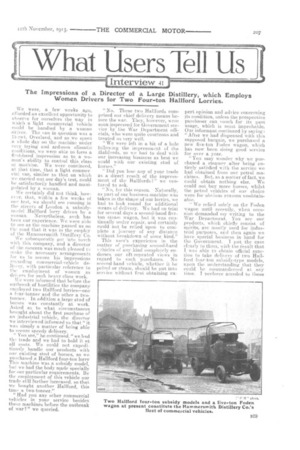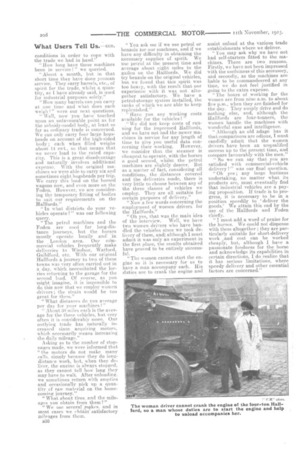at Users Tell Us
Page 7

Page 8

If you've noticed an error in this article please click here to report it so we can fix it.
The Impressions of a Director of a Large Distillery, which Employs Women Drivers for Two Four-ton Hallford Lorries.
We were, a few weeks ago, a ['lorded an excellent. opportunity to observe for ourselves the way in which a light commercial vehicle could be bandied by a woman driver. The van in question was a 13 cwt. Overland, and as we spent a whole day on the Machine tinder very trying and arduous climatic conditions, we were able to form a first-hand impression as to a W-0/TIall'S ability to control this class ot machine. We were convinced, at that time, that a light commercial van, similar to that on which we carried out our day's test, could be satisfactorily handled and manipulated by a woman.
'We certainly did not think, however, that, within a few weeks of our test, we should see running in the streets of London a subsidymodel Hanford lorry driven by a ) man, Nevertheless, such has been our experience. We were able to see as the machine passed us on the road that it was in the employ of the Hammersmith Distillery Co.
We subsequently got into touch with_ this company, and a director of the concern was much pleased to make the necessary arrangements for us to secure his impressions regarding commercial-vehicle delivery, with particular reference to the employment of women as drivers for such heavy-class work.
We were informed that before the outbreak of hostilities the company eniploy ed two Hal Ifo rd lorries—one
fourdonner and the other a twotonner. In addition a large stud of horses was constantly at. work. Asked as to what circumstances brought about the first purchase of an industrial vehicle, the director we interviewed informed us that "it was simply a matter of being able to secure speedy delivery.
" You see," he continued, "we had the trade and we had to hold it at all costs. We could not expeditiously handle our products with our existing stud of horses, so we purchased a Hallford four-ton lorry This machine was a subsidy model, hut we had the body made specially for our particular requirements. By the employment of this vehicle our trade still further increased, so that we bought another Hanford, this time a two-tonner."
'Had you any other commercial vehicles in your service besides these machines before the outbreak of war ?" we queried. "No. These two Hallfords comprised our chief delivery means before the war. They, however, were soon impressed for Government service by the War Department officials, who were quite courteous and treated us very well.
" We were left in a bit of a hole following the impressment cif the kialifords, so we had to deal with our increasing business as best we could with our existing stud of horses."
" Did you lose any of your trade as a, direct. result, of the impressment of the Hallfords?" we ventured to ask.
"No, for this reason. Naturally, as part of our business machine was taken in the shape of our lorries, we had to look round for additional means of delivery. We had on trial for several days a second-hand fiveton steam .wagon, but it was continually tinder repair, and certainly could not be relied upon to complete a. journey of any distance without breakdown of sorae. kind." This user's experience in the matter of purchasing second-hand vehicles of any kind completely endorses our oft-repeated views in regard to such purchases. No second-hand vehicle, whether it be petrol or steam, should be put into service without first obtaining ex
pert opinion and advice concerning its condition, unless the prospective purchaser can vouch for its past usage, which is most improbable. Our informant continued by saying : " After we had dispensed with this supposed bargain, we purchased a new five-ton Foden wagon, which has now been doing good service for over a year.
"You may wonder why we purchased a. steamer after being entirely satisfied with the service we had obtained from our petrol machines. But, as a. matter of fact, we could obtain nothing else. We could not, buy more horses, whilst the petrol vehicles of our choice were for obvious reasons unobtainable.
" We relied solely on the Foden wagon until reeently, when occasion demanded my writing to the War Department.. You see our products, which chiefly consist of spirits, are mostly used for industrial purposes, and then again we have special business in hand for the Government. I put. the case clearly to them, with the result that I was able to obtain official sanction to take delivery of two Hallford four-ton subsidy-type models, upon the understanding that they could be commandeered at any time. I perforce acceded to these
conditions in order to cope with the trade we had in hand."
"How long have these machines been in service " we queried.
" About a month, but in that short time they have done yeoman service. They carry barrels, etc., of spirit for the trade, whilst a quantity, as I have already said, is used for industrial purposes solely."
"How many barrels can you carry at one time and what does each weigh ? " were our next questions.
" 'Well, now 'youhave touched upon an unfavourable point as for the subsidy-model body, at least so far as ordinary trade is concerned. We can only carry four large hogsheads on account of the high-sided body ; each when filled weighs about 14 cwt., so that means that we never load to the rated capacity. This is a great disadvantage and naturally involves additional expense. With the original machines we were able to carry six and sometimes eight hogsheads per trip. We carry this load on the horsed wagons now, and even more on the Foden, However, we are considering the temporary fitting of bodies to suit our requirements on the Hallfords."
". In what districts do your vehicles operate l." was our following query.
"The petrol machines and the Foden are used for long-distance journeys, but the horees mostly operate locally and.; :in the London area. Our cdminercial vehicles frequently make deliveries to Windsor, Watford. Guildford, etc. With our original Hallfords a journey to two of these towns was very often carried out in a day, which necessitated the lorries returning to the garage for the second load. Of course, as you might imagine, it is impossible to do this now that we employ women drivers ; the strain would be too great for them."
"What distances do you average per day for your machines?" " About 30 miles each is the average for the three vehicles, but very often it is considerably more. Our outlying trade has naturally increased since acquiring motors, which necessarily means increasing the daily mileage."
Asking as to the number of stoppages made, we were informed that "the motors do not make many calls, simply because they do longdistance work, but, when they deliver, the engine is always stopped, as they cannot tell how long they may have to wait. After unloading, we sometimes return with empties and occasionally nick up a quantity of raw material on the homecoming journey."
"What about tires, and the mileages von obtain from them ? "
We use several makes. and in most cases we ebthin satisfactory mileages from them.
B30
"You ask me if we use petrol or benzole tor our machines, and if we have any difficulty in obtaining the necessary supplies of spirit. We use petrol at the present time and average about eight miles to the gallon on the Hallfords. We did try benzole on the original vehicles, but we found that this spirit was too heavy, with the result that our experience with it was not altogether satisfactory. We have a petrol-storage system installed, the tanks of which we are able to keep replenished."
" Have you any working costs available for the vehicles? '
" We did not keep costs of running for the impressed Hallfords, and we have not had the newer machines in service for any length of time to give you useful data concerning their working. However, we consider that the steamer is cheapest to operate, with the horses a good second, whilst the petrol machines are slightly dearer. But as a matter of fact, considering all conditions, the distances covered and the deliveries made, there is very little to choose between any of the three classes or vehicles we employ. They are all suitable for certain purposes of delivery." " Now a few words concerning the employment of women drivers for the Hallfords."
• " Oh yes, that was the main idea of the interview. Well, we have two women drivers who have handled the vehicles since we took delivery of them, and although I must admit it was only an experiment in the first place, the results obtained have proved to be entirely successful.
" The women cannot start the engine so it is necessary for us to have a man accompany each.. His duties are to crank the engine and assist unload at the various trade establishments where we deliver.
"You may ask why we have not had self-starters fitted to the machines. There are two reasons. Firstly, we have not been impressed with the usefulness of this accessory, and secondly, as the machines are liable to be commandeered at any time, we do not feel justified in going to the extra expense. "The hours of working for the women are from nine a.m. to about five p.m., when they are finished for the day. They simply drive and do nothing else, and, although the lia,11fords are four-tanners, the women handle the machines with wonderful ease and intelligence.
"Although an old adage has it that comparisons are odious, I must candidly admit that the women drivers have been an unqualified success up to the present time, and compare favourably with the men."
"So we can say that you are satisfied with commercial-vehicle delivery?" was our final question.
"Oh yes ; any large business undertaking, no matter what its products are, must eventually find that industrial vehicles are a paying proposition. If trade is to progress, it is necessary to be in a position speedily to 'deliver the goods.' We attain this end by the tise of the Hallfords and Foden chiefly. "1 must add a word of praise for the horses. We could not dispense with them altogether ; they are particularly suitable for short-delivery work and cost can be worked cheaply, but, although I have a passionate fondness for the horse and acknowledge its capabilities in certain directions, I do realize that it has serious limitations, where speedy delivery and other essential factors are concerned."




















